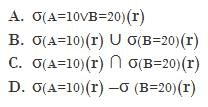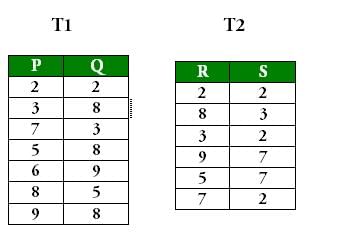Test: ER Model- 1 - Computer Science Engineering (CSE) MCQ
15 Questions MCQ Test - Test: ER Model- 1
A relation R = {A, B, C, D, E, F,G} is given with following set of functional dependencies: F = {AD → E, BE → F, B → C, AF → G} Which of the following is a candidate key ?
Given the basic ER and relational models, which of the following is INCORRECT?
Consider the following ER diagram. Find the no of tables that would be needed ?


Consider a join (relation algebra) between relations r(R)and s(S) using the nested loop method. There are 3 buffers each of size equal to disk block size, out of which one buffer is reserved for intermediate results. Assuming size(r(R)) < size(s(S)), the join will have fewer number of disk block accesses if
Consider the relational schema given below, where eId of the relation dependent is a foreign key referring to empId of the relation employee. Assume that every employee has at least one associated dependent in the dependent relation.
employee (empId, empName, empAge)
dependent(depId, eId, depName, depAge)
Consider the following relational algebra query:

The above query evaluates to the set of empIds of employees whose age is greater than that of
Let E1 and E2 be two entities in an E/R diagram with simple single-valued attributes. R1 and R2 are two relationships between E1 and E2, where R1 is one-to-many and R2 is many-to-many. R1 and R2 do not have any attributes of their own. What is the minimum number of tables required to represent this situation in the relational model?
Which of the following relational query languages have the same expressive power?
- Relational algebra
- Tuple relational calculus restricted to safe expressions
- Domain relational calculus restricted to safe expressions
What is the min and max number of tables required to convert an ER diagram with 2 entities and 1 relationship between them with partial participation constraints of both entities?
A Relation R with FD set {A->BC, B->A, A->C, A->D, D->A}. How many candidate keys will be there in R?
The relational algebra expression equivalent to the following tuple calculus expression
{ t | t ∈ r ∧ (t[A] = 10 ∧ t[B] = 20 }

is
Consider the join of a relation R with a relation S. If K has m tuples and S has n tuples, then the maximum and minimum sizes of the join respectively are:
Which of the following query transformations (i.e., replacing the l.h.s. expression by the r.h.s. expression) is incorrect? R1 and R2 are relations. C1, C2 are selection conditions and A1, A2 are attributes of R1. a. σC1( σC2R1)) → σC2(σC1(R1)) b. σC1( πA1R1)) → πA1(σC1(R1)) c. σC1( R1 ∪ R2 ) → σC1(R1) ∪ σC1(R2) d. πA1(σC1(R1)) → σC1 (πA1 (R1))
Let R(a, b, c) and S(d, e, f) be two relations in which d is the foreign key of S that refers to the primary key of R. Consider the following four operations R and S. I. Insert into R II. Insert into S III. Delete from R IV. Delete from S Which of the following can cause violation of the referential integrity constraint above?
Consider the following tables T1 and T2:

n table T1, P is the primary key, Q is the foreign key referencing R in table T2 with on-delete cascade and on-update cascade. In table T2, R is the primary key and S is the foreign key referencing P in the table T1 with on-delete set NULL and on-update cascade. In order to delete record (3,8) from table, numbers of additional record that need to be deleted from table T1 is ______. Note: This question appeared as Numerical Answer Type.





















